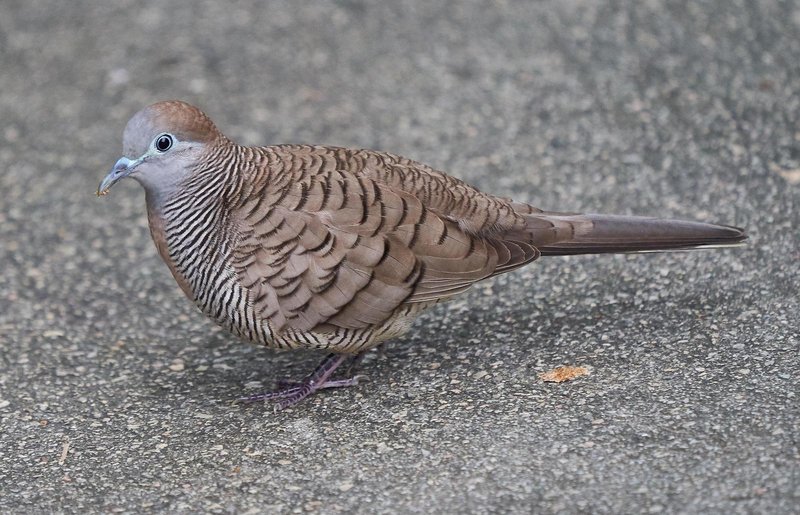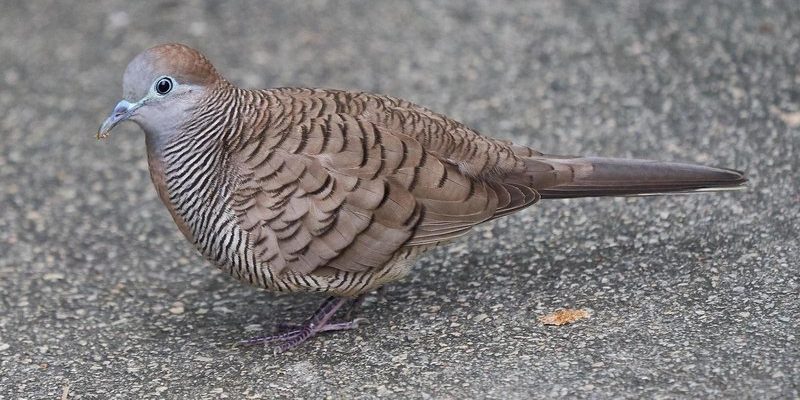
You might have noticed these doves perched on a fence or strutting around a park. Their soft cooing sound is something that brings a sense of calmness, much like the gentle breeze on a warm day. Whether you see them in your backyard or while traveling, these birds are a treat for any bird lover. So, let’s dive deeper into the life and characteristics of the Zebra Dove.
Physical Characteristics
The Zebra Dove is a modest-sized bird, typically measuring around 25 to 30 cm in length. Its most striking feature is its beautiful plumage, which resembles the patterns of a zebra—hence the name. The feathers are a mix of soft gray and brown tones, with distinctive black and white stripes running across its neck and wings. This pattern not only makes them visually appealing but also provides effective camouflage in their natural habitat.
One thing you’ll notice about the Zebra Dove is its long tail, which adds a graceful touch to their overall appearance. The males and females look quite similar, but if you pay attention, you might catch the males displaying more vibrant colors, especially during mating rituals. Their bright red eyes stand out against their muted feathers, giving them a sweet and gentle look that is hard to resist.
Interestingly, the Zebra Dove is often confused with other species, like the Spotted Dove, but the stripe pattern is a clear distinguishing factor. Their petite size and calm nature allow them to thrive in urban environments, making them one of the most common doves in Southeast Asia.
Habitat and Distribution
You might be wondering where you can find the Zebra Dove. These birds have a broad range and can be spotted in various habitats. They prefer open areas like gardens, parks, and even roadsides. Their adaptability to human environments has contributed to their widespread presence across Southeast Asia, including countries like Singapore, Malaysia, and Indonesia.
Zebra Doves thrive in both rural and urban settings. In cities, they are often seen foraging on the ground for seeds and grains, which constitute a major part of their diet. Their flexibility allows them to find food in diverse locations, from agricultural fields to suburban backyards. They tend to build their nests in trees or shrubs, but make sure these spots are close to areas where they can easily find food.
These doves are not migratory, meaning they typically stay within their established territories throughout the year. Their preference for warm climates means they are less likely to be found in colder regions. This stationary lifestyle allows them to create strong bonds with their habitats and even with the humans who enjoy their presence.
Diet and Feeding Habits
The Zebra Dove is a granivorous bird, primarily feeding on seeds and grains. You might spot them pecking around on the ground, looking for tasty morsels to nibble on. They have a particular fondness for millet and other small seeds, which are abundant in their natural habitats. Their feeding style is quite social; they often forage in small groups, making their dining experience a communal affair.
One interesting behavior you might observe is how they utilize their unique feeding technique. Zebra Doves often tilt their heads sideways while pecking at the ground, helping them spot seeds more easily. This behavior not only shows their adaptability but also highlights their charming personality. Watching them interact with each other while feeding adds a touch of joy to any outdoor experience.
In urban areas, their diet can be supplemented with food scraps from human activity. While it’s fun to throw them a few breadcrumbs, it’s essential to provide appropriate seeds to keep them healthy. Remember, treating these birds with respect and understanding their natural feeding habits ensures that they thrive in our shared spaces.
Behavior and Social Structure
Zebra Doves are known for their gentle and calm demeanor. They generally enjoy a peaceful existence, which is reflected in their soft coos and subdued movements. If you’re sitting quietly in a park, you might hear their gentle calls echoing through the trees. Their social structure is fascinating; they often form monogamous pairs that work together to raise their young.
During mating season, you might catch a glimpse of their courtship rituals. The males engage in unique displays, puffing up their chests, bowing, and cooing to attract potential mates. This behavior is not only charming to observe but also adds to the beauty of their social interactions. Once paired, these doves work together to build a nest, usually made from twigs and leaves, in a sheltered spot to protect their eggs from predators.
Zebra Doves are also quite territorial and will defend their nesting area from other birds. You might see them engaging in gentle confrontations with other doves who venture too close. This behavior indicates their strong commitment to their mates and their chosen territory. Watching their interactions can be quite entertaining, as they navigate the social dynamics of their feathered community.
Reproduction and Lifespan
The reproductive cycle of the Zebra Dove is as interesting as its other behaviors. They typically breed year-round, with peaks in activity depending on their environment. After a brief courtship, the female will lay two eggs in a simple nest. Both parents take turns incubating the eggs for about 14 to 16 days, showcasing their partnership in parenting.
Once the chicks hatch, they are fed a special substance called “pigeon milk,” which is produced by both parents. This nutrient-rich food is vital for the growth of the young doves. Within a few weeks, the chicks grow rapidly and are often ready to fledge, or leave the nest, after 12 to 18 days. The parents continue to care for them even after they leave the nest, which is a heartwarming aspect of their family structure.
In terms of lifespan, Zebra Doves can live up to 7 years in the wild. In captivity, with proper care, they can survive even longer. Environmental factors, habitat quality, and availability of food play crucial roles in their lifespan. So, if you’re lucky enough to spot a Zebra Dove, know that you’re witnessing the life of a bird that shares a deep bond with its mate and surroundings.
Conservation Status
The Zebra Dove is currently classified as a species of “Least Concern” according to the International Union for Conservation of Nature (IUCN). This status means they are not facing immediate threats to their population. However, habitat loss due to urbanization poses potential challenges. As cities expand, natural habitats are often destroyed, putting pressure on bird species like the Zebra Dove.
Despite this threat, their adaptability ensures that they continue to thrive in human-dominated environments. You might find them nesting in unusual places, showcasing their resilience and ability to thrive alongside people. Conservation efforts focusing on preserving green spaces and urban gardens can help maintain healthy populations of these charming birds.
Moreover, educating communities about the importance of biodiversity can play a significant role in ensuring that these beautiful creatures continue to exist for generations to come. Supporting local conservation initiatives and creating bird-friendly spaces can make a difference in their survival.
Fun Facts About Zebra Doves
– The Zebra Dove’s cooing sound is often described as a gentle and soothing melody, making it a popular choice for bird enthusiasts.
– They can be found in various colors, and while the standard Zebra Dove has a gray-brown hue, some may exhibit variations.
– Zebra Doves are known to be excellent fliers, capable of swift movements when escaping predators.
Table of Interesting Facts
| Scientific Name: | Geopelia striata |
| Average Size: | 25-30 cm in length |
| Diet: | Seeds and grains |
| Habitat: | Gardens, parks, urban areas |
| Lifespan: | Up to 7 years in the wild |
FAQ
What does the Zebra Dove eat?
Zebra Doves primarily feed on seeds and grains. Their diet includes small seeds like millet, which they forage for on the ground. They are social eaters, often seen foraging in groups. While they can eat human food scraps, it’s best to provide them with seeds that are more suited to their dietary needs.
Are Zebra Doves good pets?
Zebra Doves can be excellent pets for bird lovers. They are gentle, quiet, and easy to care for. However, they need a spacious cage and opportunities for exercise. Providing proper nutrition and a safe environment will ensure they thrive as pets. Just remember that they often prefer the company of their kind, so consider keeping them in pairs.
How can I attract Zebra Doves to my garden?
To attract Zebra Doves, create a bird-friendly environment in your garden. Provide bird feeders filled with seeds and create sheltered spots with shrubs or trees. Having a water source can also encourage them to visit. Keeping your garden free of predators will create a safe haven for these lovely birds.
Do Zebra Doves mate for life?
Yes, Zebra Doves typically mate for life. They form monogamous pairs and share parenting duties, which include building nests and caring for their young. Their strong bond is evident during courtship and nesting seasons, showcasing their commitment to each other.
Can Zebra Doves be found outside of Asia?
While they are primarily found in Southeast Asia, Zebra Doves have been introduced to other regions, including parts of the Pacific Islands and Australia. Their adaptability to various environments allows them to thrive beyond their native habitats, although their populations are most robust in their original territories.
What is the best way to observe Zebra Doves in the wild?
To observe Zebra Doves, it’s best to find them in parks or gardens, where they often forage. Sit quietly in a shaded area and be patient. Bring some birdseed to entice them closer, but remember not to feed them junk food. Observation is much more rewarding when you respect their natural behavior.
How do Zebra Doves communicate?
Zebra Doves communicate through a variety of soft coos and calls. Their gentle vocalizations are often heard during mating rituals and when expressing territoriality. Pay attention to their body language; they use physical displays during courtship to communicate with potential mates and rivals.
What are the main threats to Zebra Doves?
While currently classified as “Least Concern,” Zebra Doves face threats such as habitat loss due to urban development and predation by domestic animals. It’s essential to maintain green spaces and educate communities on the importance of biodiversity to help protect these lovely birds.
How long does it take for Zebra Dove chicks to fledge?
Zebra Dove chicks typically fledge, or leave the nest, around 12 to 18 days after hatching. During this time, both parents care for the chicks and provide them with “pigeon milk,” a nutritious secretion that supports their growth. After fledging, the parents continue to support their young as they learn to navigate their surroundings.
Are Zebra Doves social birds?
Absolutely! Zebra Doves are social creatures, known for their gentle nature. They often gather in small groups while foraging and are seen interacting with one another. Their social behavior makes them a delight to observe, whether in local parks or gardens.
Do Zebra Doves migrate?
No, Zebra Doves are generally non-migratory. They prefer to stay within their established territories year-round. This stability allows them to create strong bonds with their environment and the other birds in their area. They thrive in their chosen habitats, facing minimal seasonal changes.

